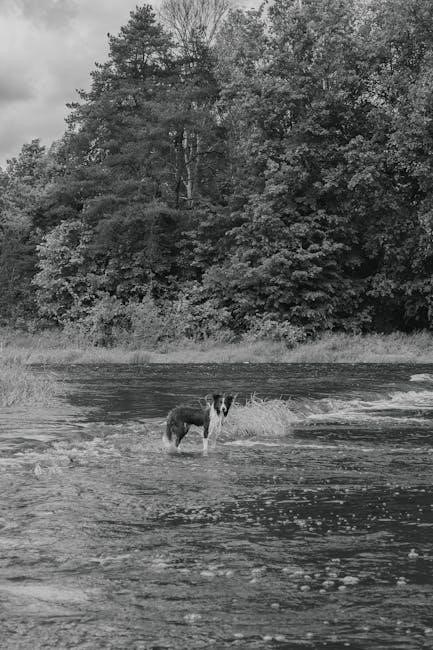Crossing the River with Dogs offers a unique approach to problem-solving‚ blending mathematical strategies with real-world applications. The book emphasizes group collaboration and critical thinking‚ providing practical tools for college students to enhance their problem-solving skills through engaging scenarios like river crossing puzzles.
Overview of the Book and Its Purpose
Crossing the River with Dogs is designed to enhance problem-solving skills through collaborative learning and real-world applications. The book focuses on developing critical thinking‚ meta-cognition‚ and mathematical strategies‚ using river crossing puzzles as a central metaphor. It aims to bridge academic concepts with practical scenarios‚ fostering teamwork and effective communication. By integrating engaging exercises and systematic approaches‚ the text prepares students for complex challenges in both educational and professional settings.
Importance of Problem Solving in College Education
Problem-solving is a cornerstone of college education‚ fostering critical thinking‚ adaptability‚ and resilience. It equips students with the ability to tackle complex challenges‚ a skill vital for future careers. By emphasizing systematic approaches and collaboration‚ problem-solving enhances analytical thinking and creativity. These skills are not only academic tools but also lifelong assets‚ enabling students to navigate real-world scenarios with confidence and innovation. The book underscores this importance through interactive exercises and practical examples‚ preparing students for diverse professional demands.

Core Strategies for Effective Problem Solving
Crossing the River with Dogs introduces systematic approaches like creating lists‚ matrix logic‚ and pattern identification. These strategies foster critical thinking‚ creativity‚ and effective collaboration in solving complex challenges.
Working in Groups and Collaboration Techniques
Crossing the River with Dogs emphasizes the importance of teamwork and communication in problem-solving. It provides structured techniques for effective group collaboration‚ such as active listening‚ role delegation‚ and conflict resolution. These methods enhance critical thinking and ensure all voices are heard‚ fostering a productive learning environment. The book also highlights how collaborative efforts mirror real-world scenarios‚ preparing students for workplace dynamics. By encouraging shared responsibility and creativity‚ it equips learners with essential interpersonal skills for tackling complex challenges together.
Developing Critical Thinking and Meta-Cognition Skills
Crossing the River with Dogs focuses on enhancing critical thinking and meta-cognition‚ enabling students to evaluate their own reasoning processes. The book introduces strategies to identify biases‚ analyze assumptions‚ and reflect on problem-solving approaches. By encouraging self-assessment‚ it helps learners understand how they think and improve their ability to adapt strategies. These skills are vital for tackling complex challenges in academia and real-life scenarios‚ fostering intellectual growth and adaptive problem-solving abilities. The text empowers students to become more aware and effective thinkers.
Systematic Approaches to Mathematical Problem Solving
Crossing the River with Dogs teaches structured methods for solving mathematical problems‚ emphasizing logical reasoning and step-by-step analysis. Techniques include creating systematic lists‚ using matrix logic‚ and applying guess-and-check methodologies. These approaches help students break down complex problems‚ identify patterns‚ and eliminate possibilities. By fostering analytical thinking‚ the book enables learners to develop a systematic mindset‚ essential for tackling mathematical challenges effectively. These strategies are complemented by real-world applications‚ making problem-solving both practical and engaging.
Mathematical Techniques Explored in the Book
Crossing the River with Dogs explores systematic problem-solving techniques‚ including creating lists‚ using matrix logic‚ and guess-and-check methods. These tools help students structure and simplify complex mathematical challenges effectively.
Creating Systematic Lists and Eliminating Possibilities
Crossing the River with Dogs teaches students to organize problems by creating detailed‚ systematic lists. This method helps identify all potential solutions and variables‚ making complex scenarios manageable. By eliminating impossible or impractical options‚ students refine their approach‚ focusing on viable strategies. This technique is particularly effective in river crossing puzzles‚ where listing constraints and systematically removing them leads to clear‚ efficient solutions. The book demonstrates how this method enhances logical reasoning and decision-making skills‚ applicable to various real-world challenges.

Using Matrix Logic and Identifying Patterns
Matrix logic and pattern identification are essential tools in Crossing the River with Dogs. By organizing data into matrices‚ students can compare values across categories‚ revealing relationships and simplifying complex problems. Identifying patterns helps anticipate outcomes and make informed decisions. These techniques are applied to river crossing puzzles‚ where recognizing recurring structures in constraints and solutions enhances efficiency. This approach not only aids in mathematical problem-solving but also cultivates analytical thinking for real-world challenges.
Guess-and-Check Methodologies and Subproblem Analysis
Guess-and-check methodologies involve proposing solutions and refining them based on outcomes‚ fostering creativity and resilience. Subproblem analysis breaks complex challenges into smaller‚ manageable tasks‚ simplifying decision-making. Both strategies are integral to river crossing puzzles‚ where trial and error‚ combined with systematic decomposition‚ help navigate constraints. These approaches encourage critical thinking and adaptability‚ proving invaluable for tackling intricate mathematical and real-world problems effectively.

Real-World Applications of the Strategies
Crossing the River with Dogs extends beyond academic puzzles‚ applying problem-solving techniques to real-world challenges in logistics‚ project management‚ and teamwork. These strategies enhance decision-making in diverse professional and personal contexts‚ demonstrating practical value in everyday situations.

Case Studies of River Crossing Scenarios
The book includes real-world case studies‚ such as scenarios involving multiple individuals and dogs crossing a river with limited boat capacity. These examples illustrate practical problem-solving techniques‚ emphasizing logical reasoning and systematic planning. Readers learn to break down complex challenges into manageable steps‚ ensuring efficient and safe crossings. These scenarios are designed to mirror real-life dilemmas‚ helping students apply the strategies to various professional and academic situations‚ fostering critical thinking and effective decision-making skills.
Practical Examples from Various Fields
The book provides practical examples from diverse fields‚ demonstrating how problem-solving strategies can be applied beyond academic settings. For instance‚ it explores scenarios in business‚ engineering‚ and logistics‚ where systematic planning and collaboration are crucial. These examples highlight how techniques like creating lists‚ using matrix logic‚ and analyzing subproblems can optimize real-world challenges‚ such as supply chain management or project optimization. This approach bridges theoretical concepts with tangible applications‚ making problem-solving accessible and relevant to everyday professional tasks.
Connecting Problem Solving to Everyday Life
Crossing the River with Dogs bridges problem-solving techniques with real-life scenarios‚ making them relatable and practical. Students learn to apply systematic thinking to everyday challenges‚ such as time management‚ budgeting‚ or logistics. By mastering strategies like prioritizing tasks and managing resources‚ learners can tackle complex situations confidently. The book’s approach demonstrates how problem-solving is not just an academic skill but a vital tool for navigating personal and professional life‚ enhancing decision-making and efficiency in daily tasks.
Detailed Analysis of River Crossing Puzzles
Crossing the River with Dogs provides in-depth examinations of river crossing scenarios‚ offering step-by-step solutions and exploring the dynamics of constraints‚ resource management‚ and logical strategies.
Understanding the Dynamics of River Crossing Challenges
Crossing the River with Dogs delves into the complexities of river crossing puzzles‚ highlighting constraints like boat capacity‚ time management‚ and resource allocation. These challenges often involve multiple characters‚ including dogs‚ each with unique abilities or limitations. The dynamics require strategic planning‚ logical reasoning‚ and creativity to ensure safe and efficient crossings. By analyzing these scenarios‚ students learn to break down problems‚ prioritize actions‚ and adapt to unpredictable variables‚ mirroring real-world decision-making processes.
Role of Dogs in the Crossing Process
Dogs play a pivotal role in river crossing challenges‚ often serving as unique elements that add complexity to problem-solving. Their presence introduces constraints and opportunities‚ requiring creative strategies to ensure their safe transport. Some scenarios highlight dogs with exceptional abilities‚ such as operating boats‚ making them indispensable to the solution. These challenges teach students to think critically about resource allocation and logical sequencing‚ emphasizing the importance of adaptability in dynamic situations. The inclusion of dogs enriches the narrative‚ making problem-solving engaging and relatable while fostering teamwork and analytical skills.
Step-by-Step Solutions to Complex Scenarios
The book provides structured‚ step-by-step approaches to tackle intricate river crossing puzzles. By breaking problems into manageable parts‚ students learn to define the problem‚ list possible actions‚ and systematically eliminate impossibilities. Techniques like working backward and identifying patterns are emphasized‚ ensuring clarity and efficiency. These methodologies are applied to real-world scenarios‚ making the solutions practical and applicable beyond theoretical puzzles. The systematic nature of these strategies helps students develop a logical mindset‚ essential for problem-solving in various fields.

Teaching and Learning Resources
Crossing the River with Dogs provides comprehensive instructor resources‚ detailed teaching guides‚ and workbook exercises. These tools enhance problem-solving skills through structured activities and real-world applications‚ benefiting both educators and students.
Instructor Resources and Teaching Guides
Crossing the River with Dogs provides educators with comprehensive teaching guides‚ offering detailed notes and suggestions for classroom activities. These resources align with the textbook and workbook‚ ensuring structured learning experiences. Instructors can access sample problems‚ assessments‚ and solutions to support student engagement. The guides emphasize practical applications‚ fostering critical thinking and collaboration. By integrating real-world scenarios‚ educators can help students connect theoretical concepts to everyday challenges‚ enhancing problem-solving skills and preparing them for future academic and professional endeavors.
Workbook Exercises and Activities
Crossing the River with Dogs includes a workbook packed with exercises and activities designed to reinforce problem-solving strategies. These exercises complement the textbook‚ offering hands-on practice in critical thinking‚ systematic approaches‚ and collaboration. Activities range from creating lists and using matrix logic to analyzing subproblems and solving real-world scenarios. The workbook provides structured tasks to help students master mathematical reasoning and apply it to everyday challenges‚ ensuring a deep understanding of the concepts explored in the main text.
Sample Problems and Solutions for Practice
The book provides an extensive collection of sample problems and detailed solutions to help students practice and master problem-solving techniques. These exercises cover a wide range of scenarios‚ from classic river crossing puzzles to complex mathematical challenges. Each problem is paired with a step-by-step solution‚ enabling students to understand the thought process and strategies used. The practice section reinforces key concepts and encourages independent learning‚ ensuring students feel confident in applying the skills they’ve learned to real-world situations.

Edition-Specific Features
The 3rd Edition of Crossing the River with Dogs introduces new chapters‚ enhanced real-world applications‚ and improved teaching resources‚ providing a comprehensive update for problem-solving education.
Updates in the 3rd Edition
The 3rd Edition of Crossing the River with Dogs introduces enhanced problem-solving strategies‚ expanded real-world examples‚ and improved instructor resources. New chapters focus on practical applications‚ while refined exercises and updated teaching guides ensure a more engaging learning experience. The edition also emphasizes meta-cognition‚ helping students better understand their thinking processes. These updates make the book more comprehensive and effective for developing critical problem-solving skills in college students.
New Chapters and Expanded Content
The 3rd Edition introduces new chapters that delve into real-world problem-solving applications‚ enriched with practical examples. Expanded content includes detailed river crossing scenarios‚ advanced mathematical techniques‚ and enhanced collaboration strategies. These additions provide students with a broader understanding of problem-solving methodologies‚ making the book a comprehensive resource for developing critical thinking and teamwork skills essential for academic success.
Enhanced Focus on Real-World Applications
The 3rd Edition places a strong emphasis on connecting problem-solving strategies to real-world scenarios‚ ensuring students can apply their skills beyond academic settings. Through practical examples and case studies‚ the book bridges theoretical concepts with everyday challenges‚ making problem-solving more relatable and actionable. This enhanced focus equips students with the ability to tackle complex situations in various fields‚ preparing them for future professional and personal challenges with confidence and practical insight.
Crossing the River with Dogs equips students with essential problem-solving skills through systematic approaches and critical thinking. It fosters collaboration and practical application‚ preparing learners for real-world challenges.
Crossing the River with Dogs emphasizes collaborative problem-solving‚ critical thinking‚ and real-world application. It teaches systematic approaches like list-making‚ pattern recognition‚ and guess-and-check methodologies. The book highlights the importance of meta-cognition‚ encouraging students to reflect on their thinking processes. By connecting mathematical strategies to everyday challenges‚ it prepares learners for practical scenarios‚ fostering skills essential for academic and professional success. The text underscores the value of teamwork and clear communication in overcoming complex problems.
Encouragement for Further Exploration
Crossing the River with Dogs inspires learners to explore problem-solving beyond the classroom. By mastering strategies like systematic lists and matrix logic‚ students gain confidence in tackling real-world challenges. The book motivates further exploration through practical examples‚ encouraging readers to apply these skills in diverse contexts. Its emphasis on collaboration and critical thinking fosters a deeper understanding of problem-solving‚ inspiring students to continue refining their abilities and seeking new ways to approach complex scenarios.

References and Further Reading
Crossing the River with Dogs is published by Key College Publishing and Wiley & Sons‚ Limited. For additional resources‚ visit their official websites or check ISBN listings for detailed references.
Recommended Resources for Deeper Understanding
For deeper insights‚ explore the official publisher’s website and ResearchGate for additional materials. The book’s ISBN‚ 1931914141‚ provides access to further references. Online communities and forums dedicated to problem-solving strategies also offer valuable discussions and resources for enhancing your understanding of the concepts presented in Crossing the River with Dogs.
Online Tools and Communities for Problem Solving
Engage with online platforms like ResearchGate and academic forums to explore deeper problem-solving strategies. Tools like Excel and Python libraries can aid in creating systematic lists and matrix logic. Join communities focused on mathematical puzzles and river crossing challenges to share insights and learn from others. These resources complement the book’s methodologies‚ offering practical applications and collaborative learning opportunities for mastering problem-solving techniques.
